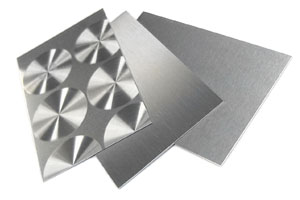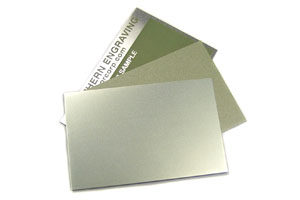Specifying Color for Nameplates
Definition of Your Target Color
Color specifying begins with the definition of a master or target color. There are several options for communicating the information across suppliers. The most common method used is the use of a mass-produced, categorized color system such as the Pantone Matching System, or PMS Book. A second method is the use of an existing color sample on basically any substrate. The least used option is a verbal or written description, since it is the most subjective.
Checklist of Additional Information Needed When Specifying Color
1. Substrates - The base substrate a color is printed on affects the character of ink and thus the ink formulation may need to be adjusted.

2. Graphic or Background - Understanding how a color will be used is critical in determining which process will be utilized in printing the color (lithography, screening, or coating).

3. Gloss - Gloss is specified in a scale ranging from no gloss (0°) to a mirror-like reflection (100°).

4. Opaques, Transparent Tints and Metallics - Special effect colors on aluminum create visual interest and add diversity to color schemes.

5. End Use Specifications - Examples of end use considerations include interior or exterior applications, chemical resistance, abrasion resistance, and UV requirements.

This is just a piece of the information that we have available on the topic of color in our eBook - Guide to Color Specifying for Product Identification. Get your copy and learn more.
Subscribe to Nameplate Blog
- 2021 (1)
- 3D (4)
- Adhesives (11)
- Aluminum (129)
- Aluminum In-mold (9)
- Aluminum Trim (41)
- Anodize (4)
- Appliance (12)
- Appliqué (5)
- Archive (35)
- Artwork Submission (4)
- Assembly (6)
- Automotive (35)
- Backlit (5)
- Boats (6)
- Brass (8)
- Brushed Aluminum (19)
- Carbon Fiber (2)
- Classic (1)
- Coined (5)
- Color Development (25)
- Computers (13)
- Cosmetics (24)
- Custom Patterns (11)
- Customization (16)
- Customized Patterns on Aluminum (2)
- Debossing (13)
- Diamond Cut (22)
- Digital Printing (2)
- ebook (4)
- Electronics (23)
- Embossing (53)
- Etched (20)
- Exterior (9)
- FAQ (29)
- Faux Finish (1)
- Faux Finishes (7)
- Favorite Nameplate (20)
- Furniture (9)
- Gauges (5)
- Gloss (4)
- Hang Tag (1)
- IDSA (1)
- In-mold Decoration (5)
- Individual Letters (7)
- Inlay (1)
- Key Fob (1)
- Labels (10)
- Large Vehicle (4)
- Laser Etch (2)
- Lithography (3)
- Match Box Cover (6)
- Materials and Processes (118)
- Mechanical Finishes (51)
- Medical Equipment (10)
- Metallic (8)
- Motorcycle (11)
- Nameplate (175)
- Nameplate Examples (54)
- Nameplate Tools (7)
- Outdoor Equipment (4)
- Overlay (7)
- Packaging (15)
- Patina Finish (3)
- Plastic (1)
- Plastic Trim (3)
- Point of Purchase (8)
- Polycarbonate (10)
- Process Color (16)
- Promotional Products (38)
- Prototypes (2)
- Recreational Vehicles (6)
- Resources (11)
- Safety Labels (2)
- Selective Patterns (10)
- Sill Plate (6)
- Sports Equipment (9)
- Stainless Steel (17)
- stock dies (10)
- Surfaces (4)
- Sustainability (1)
- Technical (1)
- Telecommunications (9)
- Testing (3)
- Texture (15)
- Top 10 (9)
- Woodgrain (2)







